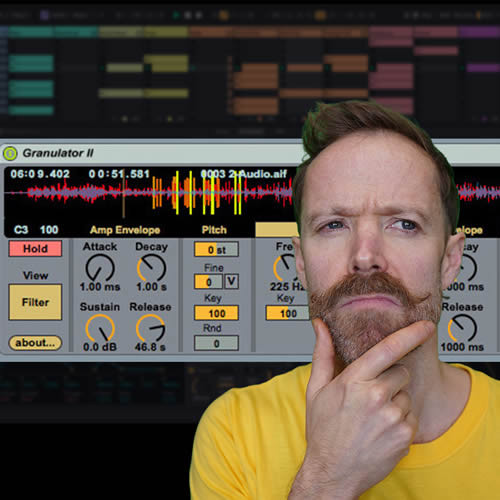Many of the glitchiest and most interesting sounds in music production are created by playing with time, whether it’s stretching it out or looping it in various ways. Granular synthesis is capable of doing both of these things to make all sorts of fantastic presets. In this article, we’ll outline some of the ways it does that.
Much like sampling or other types of synthesis, such as wavetable, granular synthesis needs some audio as a starting point. However, the aim of a granular synth isn’t necessarily to maintain much of the original sample, at least in a recognisable form, but often to transform it into something completely different!
For a great example of just how far this can go, check out Senior Tutor Rob Jones’ Techno Track made entirely with a single kick sample and granular synthesisers:
How do Granular Synths work?
After a sample has been imported, you can choose the position to start playing it and the range over which it will loop - so, like a sampler in that sense, only the loop length is referred to as Grain Size, as the sample is played by one or more grains. The number of grains and how they overlap with each other make a big difference to the sound, as does the grain size setting, which can go from the length of the sample all the way down to extremely small times that create some of the most transformative effects.

At the smaller end of the grain size spectrum, the rapidly looping grains create a particular pitch, which goes up as the size decreases and so the loop goes faster. At these times, the original sample is often unrecognisable as the loop size is so short, and the pitch you hear is the same regardless of the sample you use, so this can be fun to play with, as the patch you’re creating will stay in key and only the timbre or textural content will change when you drop in different samples.
When the grain size is larger, this allows the original sample to be heard more easily and so have more of its character come through unadulterated. However, with lots of grains playing the sample in varied ways, you can still create really interesting effects the take the sound in very cool directions.

There are a number of other parameters that can be changed to modify the sound. These include the:
• level of the grains over time (sometimes called shape or envelope), which changes the overall sound’s sharpness or smoothness for instance.
• position of the grains through the sample, which can be fixed or made to change, for example by scanning through the sample or moving back and forth through it. The former can create really interesting, glitchy time stretched effects, whilst the latter is good for movement and continual change.
On top of this, each individual grain can have its own settings made to vary, which will produce an increasingly complex and chaotic sound, especially when the number of grains is high. Grain parameters that can be changed often include:
• volume
• pitch
• grain size
Varying the grain volume is the simplest way of changing things up, although the resulting sound is very different for few grains with larger grain sizes, which can produce tremolo or gated types of effects, compared to more grains with small grain sizes, where things can start to sound much noisier and more broken up.
What Granular Soft Synths are there?
There are a number of popular granular synths, as well as synths that feature granular engines. Many of the main DAWs include granular instruments in their libraries. Ableton Live have Granulator, with the latest version Granulator III coming in Live 12, whilst Logic provide Alchemy - a very capable synth with granular engine options. Reason similarly offers a quality synth called Grain.

On the 3rd-party plugin side, you can find instruments like Audio Damage Quanta or Native Instruments Straylight, whilst other popular instruments like Arturia Pigments and Kilohearts Phase Plant both include granular generators within them.
How can I learn more about Granular Synthesis?
At Producertech, we have a number of course options to help you, with the Advanced Guide to Sound Design and Complete Guide to Phase Plant being good starting points. In addition to that, we have put together a whole set of tutorials dedicated to granular synthesis for our members, showing the basics and a number of classic and more radical patch creation examples, to provide solid foundations in the subject that help build confidence when it comes to designing patches of all kinds.
If you'd like to learn more about Granular Synthesis and many other secrets of Music Production, then become an All-Access Member today.







